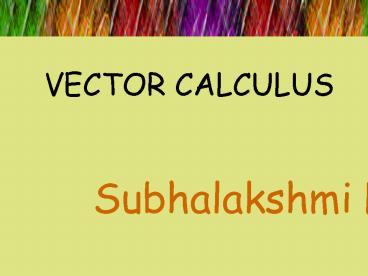VECTOR CALCULUS - PowerPoint PPT Presentation
1 / 36
Title:
VECTOR CALCULUS
Description:
VECTOR CALCULUS. Subhalakshmi Lamba. Some quantities that you have studied ... can be resolved into components along any three lines which are non coplanar. SUMMARY ... – PowerPoint PPT presentation
Number of Views:151
Avg rating:3.0/5.0
Title: VECTOR CALCULUS
1
VECTOR CALCULUS
Subhalakshmi Lamba
2
Some quantities that you have studied in your
earlier Physics Courses
- displacement
- velocity
- acceleration
- torque
- electric field
- volume
- mass
- density
- energy
- pressure
3
Scalars
A scalar is a number which defines a magnitude.
It does not point to any direction in space.
50 kg 40º C
4
What are vectors ?
A vector has a both a magnitude and a direction.
A physical quantity which has both a magnitude
and a direction is represented by a vector.
5
Examples
B
A
Displacement Electric Field
6
Vector Notation
Vectors are written as a symbol with an arrow
over the symbol
7
Representation
A vector is represented by an arrow.
The arrow points in the direction of the vector.
The length of the arrow represents the
magnitude of the vector quantity.
8
Representation (contd.)
It need not represent a length !!
9
Addition of Vectors
Triangle Law
Head-to-tail
10
Addition of Vectors
- Commutative Law
11
Addition of Vectors (contd.)
Parallelogram Law
12
Addition of Vectors (contd.)
Head-to-tail
13
Addition of Vectors (contd.)
Delhi
14
Addition of Vectors (contd.)
15
Addition of Vectors (contd.)
- Associative Law
16
Subtraction of Vectors
17
Addition of Vectors (contd.)
Can be manipulated as in usual algebra
18
- Vectors are
- geometrical objects
- independent of any
- coordinate system
Let us look for a convenient description !
19
2D Cartesian Coordinates
Look a two dimensional vector in a 2D Cartesian
Coordinate System
20
2D Cartesian Coordinates (contd.)
Y
ay
ax
21
2D Cartesian Coordinates (contd.)
22
2D Cartesian Coordinates (contd.)
Y
?
ay
?
X
ax
O
Direction cosines cos ?, cos ?
23
More on Direction cosines
The direction cosines of a vector are not
independent. They satisfy the following
relation
24
Vector Components
Resolving a vector The process of finding
the components of the vector.
Coordinate System
25
Component of a vector
The component of the vector along an axis is
its projection along that axis
26
a
3D Cartesian System
27
3D Cartesian System (contd.)
28
3D Cartesian System (contd.)
The direction cosines satisfy the following
relation
29
Unit Vectors
Magnitude 1
Indicates direction only
30
Addition of Vectors (contd.)
31
Examples
32
Examples
33
Components
A vector can be resolved into components along
any two directions in a plane containing it.
34
Components
In three dimensions, a vector can be resolved
into components along any three lines which are
non coplanar.
35
SUMMARY
- A physical quantity which has
- both a magnitude and a direction
- is represented by a vector
- A geometrical representation
- An analytical description components
- Can be resolved into components along any three
directions which are non planar.
36
REFERENCES
- Mathematical Methods for Physicists by George
Arfken - Vector Analysis by
- Murray R. Spiegel.
- Fundamentals of physics, by Halliday, Resnick and
Walker































